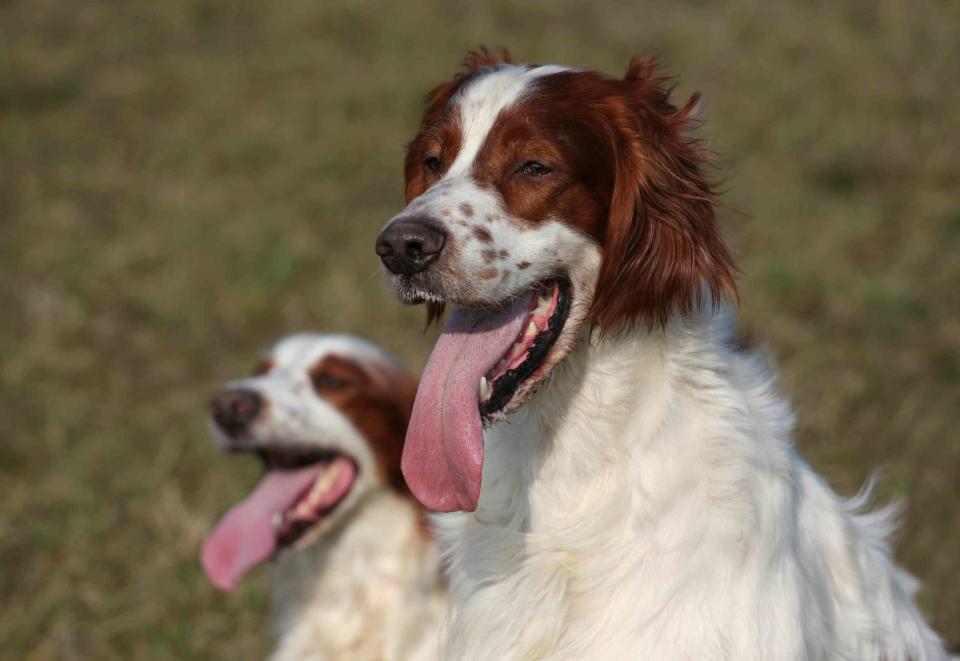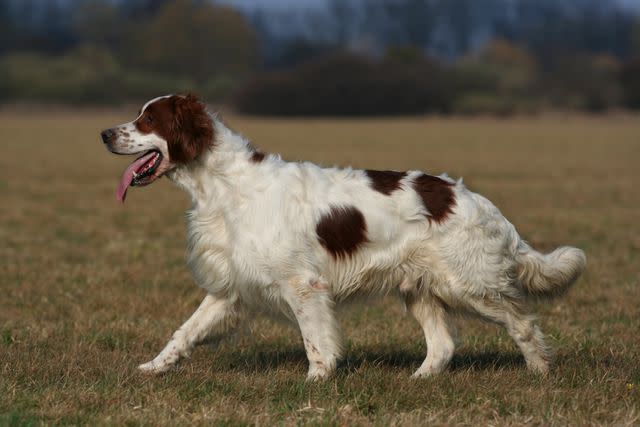Irish Red and White Setter: Breed Characteristics & Care
History, Care Tips, and Helpful Information for Pet Owners

Wavetop / Getty Images
Irish red and white setters (IRWS) are the “gentleman's hunting dog.” They're medium-sized pups with medium-length hair originally bred to hunt birds. Hailing from the Emerald Isle, the Irish Red and White setter is so much more than just a pretty coat or even a sporting dog. They’re outdoorsy pups who are intelligent, energetic, and eager to please everyone from their hunting companions to playful children. With consistent training and plenty of exercise, they can also make wonderful additions to families with other pets.
Learn more about the history, care needs, and characteristics of the Irish red and white setter.
Breed Overview
Group: Sporting
Height: 22 to 26 inches
Weight: 35 to 60 pounds
Coat: Medium with feathering, double coat
Coat Color: White with red patches
Life Span: 11 to 15 years
Temperament: Social, energetic, affectionate, loyal
Hypoallergenic: No
Origin: Ireland
Characteristics of the Irish Red and White Setter
Not ones to lounge around, the Irish red and white setter might be the perfect match for families who embrace an active lifestyle. These lively pups are ready to trot alongside you on long walks, splash around in refreshing swims, or join you for a day of upland or waterfowl hunting. Given their loyal temperament, they'll want to tag along on just about any activity.
“Irish red and white setters have plenty of energy and need lots of exercise to keep their bodies and brains healthy,” says Jennifer Sperry, DVM, a veterinarian and advisor for American Kennel Club (AKC) Pet Insurance.
They’re wonderful companions in many ways, yet Irish red and white setters are not the best guard dogs. "Most IRWS will welcome strangers into their home,” Sperry says. They're good with other dogs but require socialization and close supervision when interacting with prey animals, like cats and pet birds.
Affection Level | High |
Friendliness | High |
Kid-Friendly | High |
Pet-Friendly | Medium |
Exercise Needs | High |
Playfulness | Medium |
Energy Level | High |
Trainability | High |
Intelligence | High |
Tendency to Bark | Medium |
Amount of Shedding | Low |
History of the Irish Red and White Setter
Only formally recognized in 2009 by the AKC, the Irish red and white setter has a long history as a hunting companion dating to the 18th century. Despite facing population decline around World War I, this breed may even predate their all-red cousin, the red setter. The Irish Red and White Society of America suggests that the red-coated setters might have originated from selective breeding within the white and red lines.
Irish red and white setters were specially bred to hunt for wild game birds such as partridge and grouse hiding in cover. They use a method of hunting known as “quartering,” which involves the dog meticulously moving from one side to another, ensuring no patch of foliage is left unchecked.
“They are focused when working, with the ability to locate game birds by scent and alert their human companions with a characteristic frozen stance,” Sperry explains. Once the birds are located, well-trained pups crouch or “set” silently until their hunter gives the signal for them to flush the birds out of the brush and into the air.
Irish Red and White Setter Care
Irish red and white setters are slow-to-mature pups who generally need more physical activity and mental enrichment than many other dog breeds. So, be sure you can provide daily activity before welcoming one home—a bored IRWS can easily turn to mischief. That said, the red and white setter is friendly, dependable, and an easily trained gun dog.
Exercise
Sperry recommends that healthy adult Irish red and white setters get at least two 30-minute sessions of activity daily. This could be walking, hiking, running alongside you, swimming, or even engaging in playtime. Because they form such strong bonds with their humans and take to training easily, agility sports such as dock diving and agility training could be a good outlet for your pup’s energy.
“A large, fenced yard is ideal but apartment-dwellers who spend lots of time outdoors in parks, hiking trails, or agility rings can also provide a great life for an IRWS,” Sperry says.
Grooming
Irish red and white setters are one of four types of setters. Perhaps most similar to the Irish red setter in their hunting abilities and adaptability to family life, the red and white setter stands out for their bi-color coat of red patches on a pearly white background. With charming floppy ears, the hair of the IRWS is slightly shorter and less feathery than their red counterparts, particularly on the ears, legs, and belly.
IRWS grooming needs can be tailored to their lifestyle. For instance, burrs can easily collect on their fine, feathery top coat requiring daily upkeep. But for pups who aren't spending their days flushing out birds, Sperry says a weekly brushing and a bath as needed should do. However, Sperry recommends only using dog-safe shampoo when the coat is heavily soiled because it can strip setters of their natural oils. Regular nail trimmings every three to six weeks is best practice.

Wavetop / Getty Images
Training
Don't be discouraged by their independent spirit and seemingly boundless energy. Irish red and white setters are highly trainable partners thanks to their intelligence and eagerness to please. Start early with short, positive training sessions using positive reinforcement methods and plenty of patience. You'll be rewarded with a well-mannered, versatile companion.
Irish red and white setters can live happily with other dogs and children. But because they’re bred to hunt small animals, it’s important to socialize your IRWS around cats and other small pets in puppyhood and always supervise their interactions.
Common Health Problems
Irish red and white setters typically enjoy a lifespan of 12 to 15 years. They’re generally healthy dogs but are susceptible to a few health conditions. Choosing an Irish red and white setter puppy from a reputable breeder who conducts DNA testing for potential congenital diseases can help ensure your dog remains in good health. Purchasing pet insurance for your puppy can provide financial protection in case of unexpected illness or injury.
Hip Dysplasia: This occurs when the hip joint develops abnormally, causing the hip bone and socket to misalign and become "loose." This can lead to a range of issues, including difficulty jumping and going up stairs, limping, general pain, and early-onset arthritis. Maintaining a healthy weight reduces strain on the hip joint and can ease the symptoms. Your vet may also recommend a joint-healthy diet or, in severe cases, surgery.
Von Willebrand’s Disease: A blood clotting disorder that can lead to easy bruising, excessive bleeding after surgery, bleeding gums, bloody diarrhea, and delayed clotting after injury. While there’s no cure for this condition, dogs with vWD can get medications before surgery to control bleeding.
Canine Leukocyte Adhesion Deficiency (CLAD) I: An immunodeficiency disease that causes abnormal blood clotting as well as recurrent infections of the skin, bones, gums, and lymphatic system. Unfortunately, most affected dogs don't reach their adolescent years. However, genetic testing can identify carriers, allowing responsible breeders to avoid breeding parents who could pass the gene on to their puppies.
Meeting your potential puppy’s parents can be an important step in choosing a healthy pup with a temperament that aligns with your lifestyle.
Diet and Nutrition
Irish red and white setters don’t require a special diet outside of quality commercial dog food. Food should meet the nutritional recommendations set by the Association of American Feed Control Officials (AAFCO) for their life stage.
How many calories your dog should eat is based on your dog’s age, lifestyle, and ideal body condition. Your veterinarian can help determine the right amount of food for your individual dog. If your setter becomes overweight, your veterinarian may recommend a change in diet or portions. Table scraps can throw off your dog's balanced diet and contribute to weight gain, so offer them sparingly, if at all.
Irish red and white setters are always looking for a job to do. Snuffle mats, food puzzles, and lick mats are all great options to banish boredom and slow down fast eaters.
Where to Adopt or Buy an Irish Red and White Setter
Finding an adoptable Irish red and white setter may be challenging, as this breed is highly sought after and fairly rare. Organizations like Save Our Setters (Tennessee) specialize in rehoming setters, including Irish red and whites; there may be a setter-dedicated rescue in your area. Additionally, the Irish Red and White Setter Society of America offers a rescue program that matches dogs needing homes with suitable families. Contact them to be notified if a dog in need of a forever home becomes available.
An Irish red and white setter puppy from a responsible breeder may cost around $1,800 on average.
Irish Red and White Setter Overview
Irish red and white setters make wonderful companions for active owners who are committed to lifelong training and activity. They are happy in many living situations as long as their mental and physical enrichment needs are met.
Pros of Irish Red and White Setters
Loyal dogs who take well to training
Good around other dogs and children
Doesn't tend to drool or bark a lot
Cons of Irish Red and White Setters
Needs a significant amount of exercise and training
Requires socialization and supervision around prey animals, such as cats and pet birds
Easily becomes bored
16 Bird Dog Breeds for Avid Hunters
More Dog Breeds and Further Research
If the Irish red and white setter caught your eye, you might also like one of the other three types of setters:
Or perhaps you’d like to explore another friendly breed altogether:
There are so many wonderful dog breeds out there—including mixed breeds. With a little research, you’ll find the right one to bring home.
Frequently Asked Questions
How rare are Irish red and white setters?
There are only around 500 registered Irish red and white setters in the United States. Across the pond, their numbers are even lower. In 2019 the breed held the unfortunate title of the United Kingdom’s most endangered dog breed, with a mere 39 puppies registered that year.
Are Irish red and white setters easy to train?
Irish Red and White setters are generally easier to train than some other breeds, when gentle and patient with your IRWS pup. They’re devoted companions who crave their people's love and approval but have an independent streak. To successfully train your IRWS, keep sessions short and positive, rewarding your pup with praise, treats, and affection.
Are Irish red and white setters good pets?
The Irish red and white setter is a stunning, playful pup with a big heart, but they're not the perfect fit for every family. These energetic dogs need at least an hour of exercise and mental stimulation a day to prevent boredom and destructive behaviors. Keep in mind that they’re slow to mature, so even adopting an adolescent IRWS can lend to a puppy-like demeanor. But with proper socialization and training, they can be well-mannered companions for children and other pets; they’ve even earned the nickname "gentleman's hunting dog."
Read the original article on The Spruce Pets.

